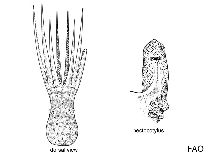Galeoctopus lateralis Norman, Boucher & Hochberg, 2004
Sharkclub octopus| Native range | All suitable habitat | Point map | Year 2050 |

|
| This map was computer-generated and has not yet been reviewed. |
| Galeoctopus lateralis AquaMaps Data sources: GBIF OBIS |
Classification / Names Populärnamn | synonymer | CoL | ITIS | WoRMS
Cephalopoda | Octopoda | Octopodidae
Environment: milieu / climate zone / djupintervall / distribution range Ekologi
Pelagiska; djupintervall 188 - 430 m (Ref. 1826). Tropical
Distribution Länder | FAO områden | Ekosystem | Förekomster | Utplanteringar
Central Pacific.
Length at first maturity / Size / Weight / Age
Könsmognad: Lm ? range ? - ? cm Max length : 16.5 cm TL hane/ej könsbestämd; (Ref. 96968); publicerad maxvikt: 18.00 g (Ref. 1826)
Life cycle and mating behavior Könsmognad | Reproduktion | Lek | Eggs | Fecundity | Larvae
Main reference
referenser | Koordinator | Medarbetare
Norman, M.D., R. Boucher and F.G. Hochberg 2004 The sharkclub octopus, Galeoctopus lateralis, a new genus and species of deep-water octopus from the western Pacific Ocean (Cephalopoda: Octopodidae). Journal of Molluscan Studies 70:247-256. (Ref. 1826)
IUCN Red List Status
(Ref. 130435: Version 2025-1)
CITES status (Ref. 108899)
CMS (Ref. 116361)
Threat to humans
Human uses
| FishSource |
Verktyg
Ytterligare information
Max. ages / sizes
Length-weight rel.
Length-length rel.
Length-frequencies
Mass conversion
Abundans
Internet-källor
BHL | BOLD Systems | CISTI | DiscoverLife | FAO(Publication : search) | Fishipedia | GenBank (genome, nucleotide) | GloBI | Gomexsi | Google Books | Google Scholar | Google | PubMed | Tree of Life | Wikipedia (Go, sök) | Zoological Record



